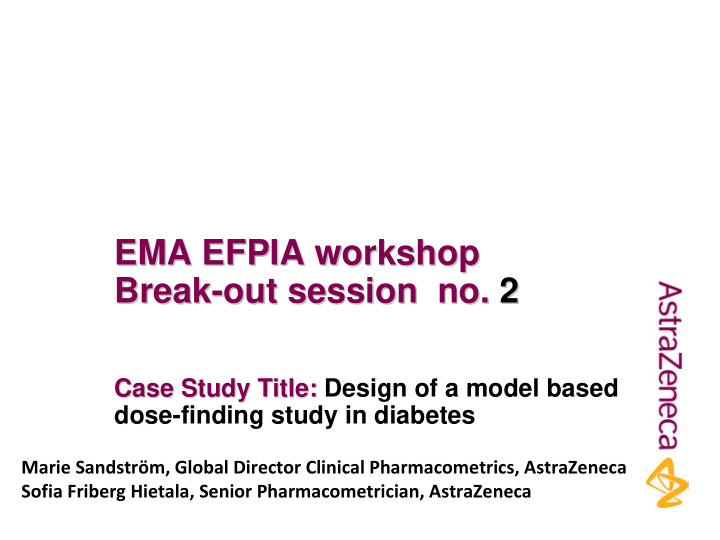



EMA EFPIA workshop EMA EFPIA workshop Break- -out session no. out session no. 2 2 Break Case Study Title: Design of a model based Case Study Title: dose-finding study in diabetes Marie Sandström, Global Director Clinical Pharmacometrics, AstraZeneca Sofia Friberg Hietala, Senior Pharmacometrician, AstraZeneca
Disclaimer The view and opinions expressed in these slides are my own and do not necessarily represent the views of AstraZeneca 2
BOS2: Position statement M&S analysis results together with prior knowledge (e.g. literature/other data) should be the the primary basis to decide on doses for phase II/III
Background & Rationale • The long term effect of an antidiabetic drug is best described through monitoring of glycosylated hemoglobin, HbA1c, which reflects the average glucose exposure during the last months prior to sampling. • Given the slow turnover of HbA1c and the fact that the required change in HbA1c is quite small relative to its variability, dose-ranging studies based on traditional pair- wize comparisons need to be long (>3 months) and large (50 /group). • We propose to use a model based approach in the assessment of the dose-response correlation based on: • There is a well established model describing the glucose driven effect on HbA1c (Benincosa 2000, Rohatagi 2008) • With a model based approach all available data are used to evaluate the dose- response correlation, thus maximizing the use of the collected data • Models describing the time-course of the effect in individual patient allow for a better understanding of the sources of variability (inter- and intraindividual differences)
Objectives of the M&S work Objectives of the M&S work To identify the dose-exposure- response and allow for the choice of optimal doses in Phase III
Available Data / Prior Models Available models: • Litterature model of FPG/HbA1c (Benincosa 2000, Rohatagi 2008) Populating the model: • Target specific data for a competitor compound describing the time-course of the effect • In-house data from previous Phase II and Phase III studies in similar patient populations describing the variability in disease parameters (FPG, HbA1c)
M&S Assumptions: The change in the primary variable, HbA1c, is driven by FPG Drug Drug K 1 K 1 cmt 1 in out FPG K 2 K 2 cmt 2 in out HbA1c Diabetes model Drug effect dFPG FPG E max Concentrat ion 1 1 K in 1 Eff 1 K out 1 Eff 2 Eff dt EC Concentrat ion 50 dHbA 1 c 2 2 K in FPG K out HbA 1 c dt
Methods Evaluation of study designs using simulation & estimation to determine: • What is the power to detect a pre-specified, minimal relevant effect? • What is the precision in parameter estimates (Emax, EC50)? • What percentage of studies are likely to result in correct Go vs No Go depending on: - Study design - Prior assumptions
M&S Results 5 doses Traditional design Model based design (t-test/ANCOVA) Information Statistical significant dose Statistical significant dose generated Allows prediction of efficacy/safety for •other duration •other doses and formulations •other populations Optimised Phase III study design Sample size 270/140 115 Cost 12/6 million US$ 5 million US$
Conclusions Conclusions • With a model based approach all time points are used to evaluate the effect, adding strength to the analysis, and reducing the required sample size • The model based analysis would allow for the prediction of efficacy/safety for: • different treatment durations • different doses and formulations • other populations • The dose-exposure-response model would facilitate an optimised Phase III study design • Potential draw-back: • How should a reduced sample size in Phase II be addressed from the perspective of achieving an adequate number of exposed patients prior to entering Phase III?
Acknowledgements AstraZeneca: Catarina Nilsson, Clinical Pharmacology Scientists Tore Persson, Statistical Science Director Jan Eriksson, Medical Science Director Johan Holmberg, Clinical Programme Director Uppsala University: Mats Karlsson, Professor Martin Bergstrand, PhD
-up up Back- Back
M&S Pre- -specification specification M&S Pre The basic structural model was pre-specified, but all parameters would be reestimated using the study data.
Sensitivity to assumptions Sensitivity to assumptions Assumptions based on known Physiology and Pharmacology no sensitivity analysis conducted
Recommend
More recommend